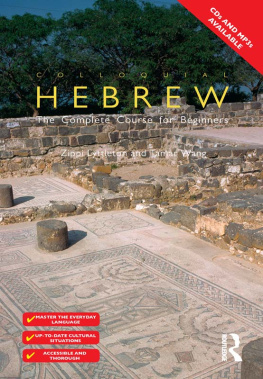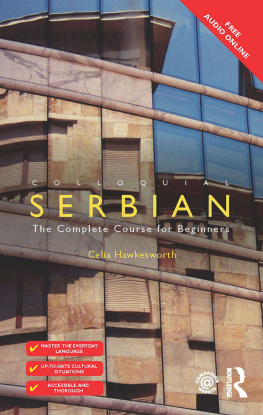Colloquial
Hebrew
THE COLLOQUIAL SERIES
Series Adviser: Gary King
The following languages are available in the Colloquial series:
| Afrikaans | French | Portuguese of Brazil |
| Albanian | German | Romanian |
| Amharic | Greek | Russian |
| Arabic (Levantine) | Gujarati | Scottish Gaelic |
| Arabic of Egypt | Hebrew | Serbian |
| Arabic of the Gulf and | Hindi | Slovak |
| Saudi Arabia | Hungarian | Slovene |
| Basque | Icelandic | Somali |
| Breton | Indonesian | Spanish |
| Bulgarian | Irish (forthcoming) | Spanish of Latin |
| Cambodian | Italian | America |
| Cantonese | Japanese | Swahili |
| Catalan | Korean | Swedish |
| Chinese | Latvian | Tamil |
| Croatian | Lithuanian | Thai |
| Czech | Malay | Turkish |
| Danish | Mongolian | Ukrainian |
| Dutch | Norwegian | Urdu |
| English | Panjabi | Vietnamese |
| Estonian | Persian | Welsh |
| Filipino | Polish | Yoruba (forthcoming) |
| Finnish | Portuguese |
COLLOQUIAL 2s series: The Next Step in Language Learning
| Chinese | German (forthcoming) | Spanish |
| Dutch | Italian | Spanish of Latin |
| French | Russian | America |
Colloquials are now supported by FREE AUDIO available online. All audio tracks referenced within the text are free to stream or download from www.routledge.com/cw/colloquials. If you experience any difficulties accessing the audio on the companion website, or still wish to purchase a CD, please contact our customer services team through www.routledge.com/info/contact.
Colloquial
Hebrew
The Complete Course
for Beginners
Zippi Lyttleton and Tamar Wang
First published in 2004 by Routledge
2 Park Square, Milton Park, Abingdon, Oxon, OX14 4RN
Simultaneously published in the USA and Canada
by Routledge
711 Third Avenue, New York, NY 10017
Routledge is an imprint of the Taylor & Francis Group,
an informa business
2004 Zippi Lyttleton and Tamar Wang
Typeset in TimesTen by
g-and-W PUBLISHING, Oxfordshire, UK
All rights reserved. No part of this book may be reprinted or reproduced or utilized in any form or by any electronic, mechanical, or other means, now known or hereafter invented, including photocopying and recording, or in any information storage or retrieval system, without permission in writing from the publishers.
British Library Cataloguing in Publication Data
A catalogue record for this book is available from the
British Library
Library of Congress Cataloging in Publication Data
A catalog record for this book has been requested
ISBN 978-1-138-94971-3 (pbk)
Contents
Please email AcademiceBooksSupport@informa.com with proof of purchase to obtain access to the supplementary content for this eBook. An access code and instructions will be provided.
Acknowledgements
Sincere thanks and appreciation are due to Sarena Alfandary for her successful matchmaking working together on this project was great fun; to Adam Albion, who generously gave of his time to pilot our first few units his encouraging comments and useful suggestions were beacons of light in the early days; to Sally Levy and Aviva Karlinski, who, despite the difficult times, provided much needed back-up and encouragement from home ground in Israel, with punchy names, jokes, realia and all kinds of information; to Sally for her introduction to the Ulpan Akhvah in Rishon Le Zion whose wonderful staff opened their doors and offered important insights; to Zehavah Meyusef for her expertise in Hebrew grammar and invaluable advice on colloquial and accepted usage; to Harvey Miller and Ofra and Jeff Graham for commenting on the completed draft; to Haya Vardy, illustrator, for her drawings that so effectively animate the text; to Gary King, Series Editor, Sophie Oliver, Language Editor, and Ruth Jeavons, Production Editor, at Routledge, without whom this book would never have been started, and very importantly, finished; to all pupils, colleagues and friends whose helpful comments throughout the writing were always greatly appreciated; and last, but of course not least, to our long-suffering families and friends who put up with us working into the small hours.
This book has seen us through sad times and happy, some of the most painful times in the history of the Middle East, alongside family celebrations and many vicissitudes of life and computers. We hope this book will make a contribution towards broadening communication and understanding, and we thank the very many people who have encouraged us along the way and helped bring it to fruition.
Introduction
About this book
Colloquial Hebrew aims to teach Hebrew as it is spoken in Israel today, to give you a level of competence to be able to travel around and to converse generally on a range of topics. Being able to read menus, road signs, posters, brochures as well as to catch snippets of conversations, are part and parcel of this competence. It will help you to understand, be understood and to feel more a part of what is going on around you.
Each lesson or unit contains dialogues of everyday encounters and situations, which introduce vocabulary and language points you can practise in the exercises that follow. We hope our dialogues will be entertaining as well as realistic and that you will find a good variety of exercises to allow you ample opportunity to gain confidence in your fast-growing skills.
We strongly recommend that you do all the exercises, as they progress in difficulty, allowing you to learn step by step, and we hope you will enjoy the journey to proficiency. At the end of the book is a key so that you can check your answers. Some answers to exercises will also give a transliteration and/or a translation, so don't give up if an exercise looks too difficult to decipher at first sight! You will also find glossaries of vocabulary taught, together with a grammar section, which draw together major points in schematic form for easy reference.
Hebrew is a logical, elegant and highly accessible language. It is a shame that the biggest stumbling block for many students comes right at the beginning: at first sight Hebrew's unfamiliar alphabet may seem an insurmountable obstacle. Yet the Hebrew alphabet is not as alien as it might appear, since it lies at the base of English and other Indo-European languages. The names of the letters in the English alphabet are remnants of old Hebrew words representing the ancient letters. Hebrew is closely related to ancient Phoenician; the ancient Greeks who traded with the Phoenicians were the first to adopt their alphabet around 800 BCE, and added signs for vowels missing in the Semitic alphabet. Initially, Greek too was written from right to left like Hebrew, and when they started to write from left to right some of the letters were turned around. Playing around with a couple of the Phoenician letters below, you will soon see the resemblance to the English letters we use today.













